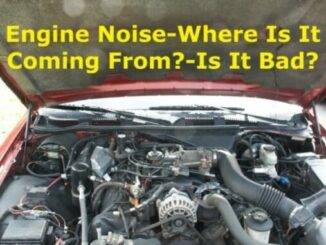
Engine bearing replacement, is really not as hard as it sounds.
So, if you have a bearing failure, learning how to replace engine bearings, can save you a ton of money.
Consequently, doing your own engine bearing replacement can be very gratifying, and give you a good sense of accomplishment.
First, engine bearing replacement, is not a common repair. They usually wear out, because of other engine functions, not those of the bearing itself. Actually, under ideal conditions, a bearing will usually never fail.
So, problems with engine bearings will usually result in, some sort of knocking noise coming from your engine. And, the type of knocking noise, will usually give you a good idea of which engine bearing is faulty.
Bad Main Bearing Sounds:
- If you hear knocking sounds, when you start your engine.
- That sound continues, while the engine is running.
- The sound is coupled with, low oil pressure warnings.
Bad Connecting Rod Bearing Sounds:
- If the knocking engine noise sounds more like, striking a piece of tin or aluminum.
- If the knocking increases in intensity, as you accelerate.
Engine Bearing Replacement ( step by step )
1. Especially important, before disassembly. Number each connecting rod and matching cap, according to cylinder location. And, each main bearing cap, as to its location in the block.
2. Loosen cap screws and lift main bearing caps, until free from block. Use cap screws as a lever, to free stubborn caps.
3. Measure housing bore dimensions, with a dial bore gauge or inside micrometers.
4. Use a micrometer to measure size, roundness and taper of the crankshaft. This is vital, during engine bearing replacement.
5. One method to check the surface finish of a crankshaft. Rub a one cent coin, several times across the surface of the shaft. If the shaft picks up copper from the coin, the shaft is too rough and must be polished.
6. Also, any burrs found at the oil holes of the crankshaft, must be removed, using a stone, file or scraper.
7. All oil passages must be clean. Clean these passages with a brush and solvent. You can also use clean, dry, compressed air.
8. Select the correct part number and under size bearing, to suit the, correct engine application.
9. Using a clean, lint free cloth, wipe bearing back and bore surfaces. Above all, they must be clean and dry. Furthermore, never put anything between the bearing back and bore surface.
10. Also, oil hole in block must line up with hole or slot in bearing, to assure proper oil flow.
11. All rubber crankshaft seals must be put together, with the sealing lip facing toward, the inside of the engine.
12. Always, use a good supply of lube, on all bearing surfaces and seal lip, during engine bearing replacement.
13. Place the crankshaft gently and squarely onto the main bearings. Install main caps, in proper position.
14. All threads must be clean and lightly lubed, to obtain correct torque readings. Finally, tighten all bolts and cap screws, with a torque wrench to proper torque specs. Do not attempt to guess, at torque tightening.
15. In addition, use a feeler gauge of proper thickness. Then, check the clearance between crankshaft thrust bearing and the bearing flange surface.
16. Before installing the piston and rod assembly. First, cover rod bolt threads with suitable protectors, to prevent nicking the crankshaft, during engine bearing replacement. A short piece of rubber hose is good for this purpose.
17. Place matching number cap on connecting rod. Finally, torque rod bolts to proper spec.
18. Priming the engine is most important. Consequently, this is to prevent dry start and early damage to bearing surfaces.
Conclusion
Above all, the most important factor is oil. So, as long as there’s a steady flow of clean oil, a bearing will usually never fail. But, if the oil’s dirty or if the oil supply is cut off, that’s when bottom end problems start. Finally, at that point you need to decide if, engine bearing replacement is your best choice.
BY DANNY BENDER




